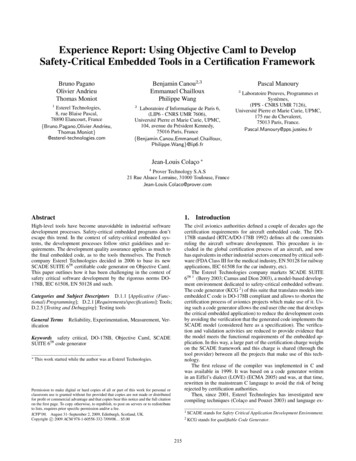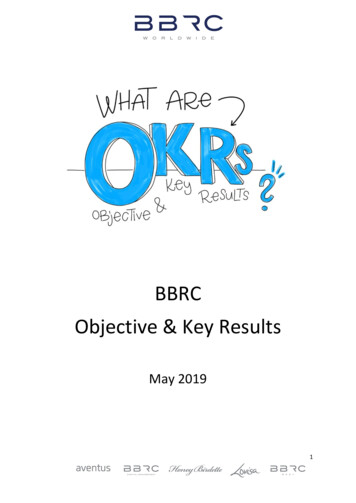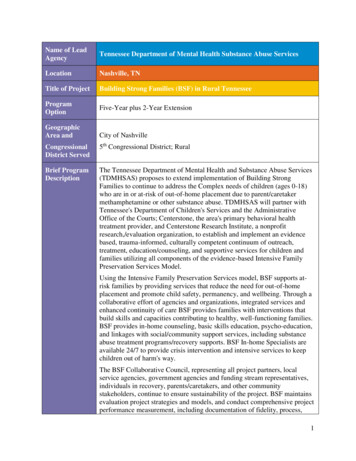
Transcription
Experience Report: Using Objective Caml to DevelopSafety-Critical Embedded Tools in a Certification FrameworkBenjamin Canou2,3Emmanuel ChaillouxPhilippe WangBruno PaganoOlivier AndrieuThomas Moniot1Esterel Technologies,8, rue Blaise Pascal,78890 Elancourt, @esterel-technologies.com2Laboratoire d’Informatique de Paris 6,(LIP6 - CNRS UMR 7606),Université Pierre et Marie Curie, UPMC,104, avenue du Président Kennedy,75016 Paris, Wang}@lip6.frPascal Manoury3Laboratoire Preuves, Programmes etSystèmes,(PPS - CNRS UMR 7126),Université Pierre et Marie Curie, UPMC,175 rue du Chevaleret,75013 Paris, France.Pascal.Manoury@pps.jussieu.frJean-Louis Colaço 4Prover Technology S.A.S21 Rue Alsace Lorraine, 31000 Toulouse, evel tools have become unavoidable in industrial softwaredevelopment processes. Safety-critical embedded programs don’tescape this trend. In the context of safety-critical embedded systems, the development processes follow strict guidelines and requirements. The development quality assurance applies as much tothe final embedded code, as to the tools themselves. The Frenchcompany Esterel Technologies decided in 2006 to base its newSCADE SUITE 6TM certifiable code generator on Objective Caml.This paper outlines how it has been challenging in the context ofsafety critical software development by the rigorous norms DO178B, IEC 61508, EN 50128 and such.The civil avionics authorities defined a couple of decades ago thecertification requirements for aircraft embedded code. The DO178B standard (RTCA/DO-178B 1992) defines all the constraintsruling the aircraft software development. This procedure is included in the global certification process of an aircraft, and nowhas equivalents in other industrial sectors concerned by critical software (FDA Class III for the medical industry, EN 50128 for railwayapplications, IEC 61508 for the car industry, etc).The Esterel Technologies company markets SCADE SUITE6TM 1 (Berry 2003; Camus and Dion 2003), a model-based development environment dedicated to safety-critical embedded software.The code generator (KCG 2 ) of this suite that translates models intoembedded C code is DO-178B compliant and allows to shorten thecertification process of avionics projects which make use of it. Using such a code generator allows the end user (the one that developsthe critical embedded application) to reduce the development costsby avoiding the verification that the generated code implements theSCADE model (considered here as a specification). The verification and validation activities are reduced to provide evidence thatthe model meets the functional requirements of the embedded application. In this way, a large part of the certification charge weighson the SCADE framework and this charge is shared (through thetool provider) between all the projects that make use of this technology.The first release of the compiler was implemented in C andwas available in 1999. It was based on a code generator writtenin an Eiffel’s dialect (LOVE) (ECMA 2005) and was, at that time,rewritten in the mainstream C language to avoid the risk of beingrejected by certification authorities.Then, since 2001, Esterel Technologies has investigated newcompiling techniques (Colaço and Pouzet 2003) and language ex-Categories and Subject Descriptors D.1.1 [Applicative (Functional) Programming]; D.2.1 [Requirements/specifications]: Tools;D.2.5 [Testing and Debugging]: Testing toolsGeneral TermsificationReliability, Experimentation, Measurement, Ver-Keywords safety critical, DO-178B, Objective Caml, SCADESUITE 6TM code generator Thiswork started while the author was at Esterel Technologies.Permission to make digital or hard copies of all or part of this work for personal orclassroom use is granted without fee provided that copies are not made or distributedfor profit or commercial advantage and that copies bear this notice and the full citationon the first page. To copy otherwise, to republish, to post on servers or to redistributeto lists, requires prior specific permission and/or a fee.ICFP’09, August 31–September 2, 2009, Edinburgh, Scotland, UK.Copyright c 2009 ACM 978-1-60558-332-7/09/08. . . 5.00Introduction1 SCADE2 KCG215stands for Safety Critical Application Development Environment.stands for qualifiable Code Generator.
tensions (Colaço et al. 2005). The aim was to demonstrate that using an academic approach for the specifications of the language(types systems, etc.) and Objective Caml (OCaml) for its implementation was also an efficient and clean approach for an industrial project The project quickly led to the expected good technicalresults but took some time to convince managers that such an approach should be accepted by a reasonable certification authority.It has now appeared that OCaml allowed to significantly reducethe distance between the specifications and the implementation ofan engineering tool, to have a better traceability between a formal description of the input language of the tool and its compilerimplementation. Thus, Esterel Technologies has designed its newSCADE SUITE 6TM in OCaml.This paper describes the specific development activities performed by Esterel Technologies to certify KCG with the severalnorms: DO-178B, IEC 61508 and EN 50128. The differences andparticularities of these standards are not in the scope of this paper;for convenience, we focus on the FAA standard (DO-178B, levelA).2.In a DO-178B compliant project, to ensure that the software satisfies all the requirements and that any single line of the softwareis necessary to its purpose, nothing can appear in the code withoutbeing clearly specified and identified first with a good traceabilityto high-level requirements (the specifications). These traceabilitylinks pass through architectural design and detailed design requirements.The choice of a programming language close and adapted to thesoftware to develop is very important since a well-suited languageleads to a simpler and more direct way to encode the softwarerequirements and consequently, a better and simpler traceability.In the same vein, when the programming language is adaptedto the developed software, the architecture of the software is closeto the functional description of the software. The links between architecture and specifications, and between architecture and detaileddesign are simpler to establish and verify.The code is tested but it is also reviewed by other developers.To ease this verification, the code must be short (in the sense thatit contains more about fundamental algorithms than on resourcemanagement) and readable.Furthermore, the libraries and especially the system library haveto be treated in the same way as the main source code: it is mandatory to have the same traceability and verifications on any specificpart of the code.So, the choice of a suitable programming language is relevantfor the various verification activities required in DO-178B compliant projects. This is, of course, always true, but becomes crucialwhen one has to defend a project in front of a certification authority.Certification of safety critical codeThe well known V-cycle dear to the software engineering industry is the traditional framework of any certified/qualifiable development project. Constraints are reinforced by DO-178B but theprinciples stay the same: the product specifications are written bysuccessive refinements, from high level requirements to low leveldesign and then implementation. Each step involves several independent verification activities: checking complete traceability of requirements between successive steps, testing each stage of codeproduction with adequate coverage, code and coding rules ptSoftwareHigh ignIntegrationtestingDetailedDesignUnitarytesting A decision is the Boolean expression evaluated in a test instruc-tion to determine the branch to be executed. It is covered if testsexist in which it is evaluated to true and false. A condition is an atomic subexpression of a decision. It iscovered if there exist tests in which it is evaluated to true andfalse. The MC/DC requires that, for each condition c of a decision,there exist two tests which must change the decision value whilekeeping the same valuations for all conditions but c. It ensuresthat each condition can affect the outcome of the decision andthat all contribute to the implemented function (no dead code iswanted).CodingFigure 1. V-cycle2.1Code coverageThe DO-178B defines several verification activities and, amongthese, a test suite has to be constituted to cover the set of specifications of the software in order to verify and to establish the conformity of their implementation. As any activity during a DO-178Bcompliant development process, the verification activities are evaluated. Some criteria must be reached to decide that the task hasbeen completed. One of these criteria is the activation of any partof the code during a functional test. On this particular point, morethan a complete structural exploration of the code, the DO-178Bstandard requires that a complete exploration of the control flowhas to be achieved following the Modified Condition / DecisionCoverage (MC/DC) measurement that we explain below.The programming language in the development processTraceability is one of the keywords of the compliance to DO-178B,any part of any activity of the project cycle pertains to other partsof the previous and of the following activities. For instance, anyrequirement of the detailed design has to be related to one or severalrequirements of the architecture design and to the lines of codeimplementing this requirement. Furthermore, the relation has toexist with the corresponding verification activity. In our example,the detailed design requirement has to be related to unitary tests thatexercise this requirement. The evidence of these relations is one ofthe most important documents of a certification file.The MC/DC is properly defined on an abstract Boolean dataflow language (Hayhurst et al. 2001) with a classical automata pointof view. The measure is extended to imperative programming languages, especially the C language, and is implemented in verification tools able to compute this measure.The challenging consequences of the choice of OCaml insteadof the usual C or ADA on MC/DC test campaigns is described insection 4.216
2.3Source to object code traceabilityThe high-level requirements that specify the static and dynamicsemantics of the Scade language involve logical inference rules.The distance between such a form of requirements and a programwritten in ML is small and the implementation is very routine, evenstraightforward for some parts. Indeed:The code verification takes place essentially on the source code.But, the real need is to assert that all verified properties of thesource code are also properties of the object code and, indeed, theexecutable binary. Most of the time these verifications activities areneither possible to do on the binary, nor on the object file.To handle this contradiction, the process requires to verify thatthe properties of the source code are also properties of the objectcode. The compiler analysis focuses on three points: the functional abstraction and the modularity of OCaml arehigh-level enough to be used as architectural requirements (direct traceability). the extensive usage of algebraic data types and pattern matchingmeets the algorithmic description. this functional architecture based on well identified compilerphases allows an independent validation of each pass. the traceability of the object code generation: by transitivity,one can deduce from that, the traceability of the requirementsin the object code. the management of the system calls: processes for safety criticalapplications are very suspicious about calls of system subroutines. conservation of the control flow: the code coverage measurement is relevant if and only if the control flow is traceable fromsource to object code.As any modern functional language, OCaml benefits from acompiler that produces trustable applications, safer than most ofthe mainstream languages which require to make use of dedicatedverification tools. In particular, the safety of its static typing allowsto skip some verifications that would be mandatory with otherlanguages: among the most evident are the memory allocation,coherency, initialization checks, which are no longer relevant andcan therefore be omitted when using OCaml.The OCaml code is compact, which allows to concentrate theverification efforts on the real difficulties, i.e. the algorithmic ones,and very little efforts are devoted to data encoding or resourcemanagement issues.On the other hand, some of the high-level constructs of this programming language may have a bad incidence on the verificationactivities. We decided not to support the complete OCaml language,and thus forbade or restricted the usage of the most complex parts:More than the choice of a programming language, a DO-178Bproject manager has to choose the complete development suite, integrating the code generator and test management tools which willbe the most convenient to manage all the development activities;including coding but also all the verification activities about thiscoding.Section 5 describes how the three above requirements can beaddressed.3.Using OCaml in the development process the object-oriented paradigm is not used for the reason that theOCaml is a functional, imperative and object oriented ML dialect.The development environment provided by INRIA contains a native compiler dedicated to the most common architectures3 .As a functional language, OCaml is adapted to symbolic computation and so, particularly suitable for compiler design and formal analysis tools which rely mainly on symbolic computation. Aswell for its bootstrapping (Leroy et al. 2008), OCaml is used in Lucid Synchrone (Pouzet 2006), the à la Lustre language for reactivesystems implementation, or the Coq (Project 2006) proof assistantimplementation. Some years ago Dassault major avionics industryapproached the use of OCaml in software engineering for safe realtime programs development. The experience of Surlog with AGFL4and the usage of Astrée (Cousot et al. 2005) by AIRBUS industriesshow that tools written in OCaml can be integrated in a criticalsoftware development process.The Esterel Technologies project presented in this paper is acode generator, named KCG, that translates SCADE models (dataflow with state machines) into embeddable C code. SCADE is aLustre(Halbwachs et al. 1991) dialect (program directed by equations with time constructions) enhanced by powerful control flowconstructions (automata).KCG has a classical architecture: a front-end with several stepsof type-check, a middle-end performing a scheduling and translation of the equational and temporal source language into an imperative intermediate language, and a back-end which generates abunch of C files. It also contains several optimization passes. A particularity of KCG compared to other compilers resides in its abilityto ensure a maximum of traceability between the input model andthe generated C program. KCG is specified in a 500 page documentcontaining more than a thousand high-level requirements: one thirdof them describe the functional requirements of the tool, the othersexplain the semantics of the input language.3 Incontrol it offers is very difficult to manage statically, modules and functors constructions are allowed but withoutsome unnecessary constructs such as the manifest types andother artifacts, exceptions and higher-order constructions are restricted by specific coding rules to avoid complex behaviors that would otherwise be hard to verify.While using OCaml in a development process has undeniableadvantages, it remains to answer the specific requirements of thesafety-critical software context. This point is addressed in the twofollowing sections.4.Code Coverage for OCaml programsAn OCaml program such as KCG uses two kinds of library code:the OCaml standard library, written mainly in OCaml, and the runtime library, written in C and assembly language. Both are shippedwith the OCaml compiler and linked with the final executable. Thedifficulty of specifying and testing such low-level library code ledus to adapt and simplify it.The bulk of the modifications of the runtime library was toremove unessential features according the coding standard of KCG.In particular, the support for concurrency and serialization wasremoved.Most of the work consisted in simplifying the efficient but complexmemory management subsystem. We successfully replaced it by aplain Stop&Copy collector with a reasonable loss of performance.As most of the standard library is written in plain OCaml, itscertification is no more difficult than that of any OCaml application.Regarding the OCaml part, we developed a tool, called mlcov5 ,capable of measuring the MC/DC rate of OCaml programs. Thetool first allows to create an instrumented version of the source codethat handles a trace file. Running the instrumented executable thenthe sequel OCaml compiler will design the INRIA OCaml compiler4 www.surlog.com5 e-software/217
leads to (incremental) update of the counters and structures of thetrace file. Finally, the coverage results are presented through HTMLreports generated from the trace file.MC/DC for OCaml sources Since OCaml is an expression language, we have to address the coverage of expression evaluation:we state that an expression has been covered as soon as its evaluation has ended. Expressions are instrumented with a mark allowing to record by side-effect that this point of the program hasbeen reached. Some constructions of the OCaml language (such asif then else) may introduce several execution branches. Coverage of expressions entails tracing the evaluation of each one ofthe branches independently. These transformations are detailed in(Pagano et al. 2008).The mlcov implementation The mlcov tool is built on top of thefront-end of the OCaml compiler. For our specific purposes, a firstpass is done, prior to the instrumentation stage, in order to rejectOCaml programs that do not comply with the coding standard ofKCG.The figure 2 shows a source code annotated according to testprograms: conditions in light gray fulfill the MC/DC criterion,while those in dark gray are not completely covered. And the figure3 gives the structural coverage and MC/DC statistics for these tests.Figure 3. Coverage ratesActually, not only does the executed object code of an OCamlprogram consist of the generated code but also includes some service assembly code, the runtime library and the so-called standardOCaml libraries. All those components are linked together at theend of the compilation step.As noticed in section 4, the set of OCaml libraries had beenslightly simplified to keep only the ones written in OCaml, thus itfalls under the regular treatment of pieces of OCaml code. The runtime library, developed in C, is mainly concerned with garbage collection. A little static assembly code provides mechanisms for external calls to memory management C functions and for exceptionhandling. As for any OCaml application, when compiling KCG,an ad hoc piece of assembly code is generated to set the optimizedmechanism of functional application of OCaml. The code for all thestandard and runtime libraries used in KCG is reasonably compact,especially after the drastic simplification of the GC. External callsare well confined in small static assembly code and no use of thelibc library can escape from it. So, fulfilling the two requirementscited above (traceability and safe management of system calls) forthis part of OCaml programs can be done by following the usualprocess.To deal with the generated code, we first benefited from thefacts that the source code of the OCaml compiler is open and itsfunctional architecture designs a clear process of refining step bystep the intermediate languages, from the abstract syntax tree tothe assembly code. The OCaml compilation is itself traceable inthe sense that all the intermediate rewritings of the source programcan be pretty-printed. It is notable that the bootstrapped OCamlcompiler itself naturally offers the traceability facilities that wereintentionally designed for the KCG code generator (see section 3).It is possible to stop the OCaml compiling process after theemission of assembly code. Then, one can assemble by hand andlink all the components, using the same command as the one thecompiler would have used, and finally obtain the same executableas the one the full compiling process would have produced. As aconsequence, it is enough to establish traceability from source codeto assembly code: a test set can consist in a piece of OCaml codeas input and its corresponding piece of assembly code as expectedoutput.At this level of the expertise, three main points had to be takeninto consideration:Figure 2. Annoted source codePerformance Results Performances are good enough for codecoverage analysis since this activity mainly consists in applying alot of pretty small examples targeting specific requirements.5.Traceability from sources to binariesA DO-178B level A software development imposes to give evidence about the trustability of the tools and compilers used in theprocess. To reach this goal, we expertized the OCaml compilingprocess in order to set up hints for the traceability from the sourcecode to the object code. On the basis of this expertise, among otherrequired documentation, test sets have been produced and are partof the bunch of documents for the certification of KCG.We present in this section the guidelines of this study, mainlyfocused on two points: the safe management of system calls andthe traceability of control flow. the translation of explicit controls of the source code, includingpattern matching and exception handling;218
the controls introduced by the compiler itself which are indeeding software engineering tools. In the transportation domain, ProverTechnology also provides certifiable solutions for automating verification activities. To meet a high level of certification (SIL 4 in IEC61508 standard) required by these applications, a diversified implementation of some software modules present in the toolchains. Thisdiversification consists in having two implementations each usingits own implementation technology and comparing the result. Forthis purpose, OCaml has been chosen jointly with the mainstreamC language. This different approach of certification is another opportunity for functional languages.few and have been tracked; the so called primitive functions which may either be translatedto assembly language or generate calls to external functions.Concerning the first point, rather than an unfeasible full correctness test of the OCaml compiler, we proceeded to a review of itsdesign principles, deep enough to set a methodology able to ensurethe above intended properties of the compiler for a given OCamlapplication (restricted to the coding standard of the project).Concerning the second point, a detailed review of the code ledus to enumerate the few occurrences where tests are generated:memory allocation, call to the GC, division by 0, access to arrayor string elements and the mechanism of functional application.In each case, either one can design test sets to cover them, or thebranching may stop the program in a safe state6 .Concerning the third point, all the primitives actually appearin the intermediate lambda code and an exhaustive study of theirappearance in the generated assembly code has been performed.6.The main result for the ICFP community is that the use of our favorite languages to build compilers is starting to be well understoodand accepted by industrial processes and certification authorities inthe context of software engineering tools. We can be optimistic tosee that, in the middle of all the mainstream (and efficient for otherpurposes) languages, there is a room for functional technologiesand culture.ReferencesConclusionGérard Berry. The Effectiveness of Synchronous Languages for theDevelopment of Safety-Critical Systems. Technical report, EsterelTechnologies, 2003.Jean-Louis Camus and Bernard Dion. Efficient Development of Airborne Software with SCADE SuiteTM . Technical report, EsterelTechnologies, 2003.Jean-Louis Colaço and Marc Pouzet. Clocks as First Class AbstractTypes. In Third International Conference on Embedded Software (EMSOFT’03), Philadelphia, Pennsylvania, USA, oct 2003.Jean-Louis Colaço, Bruno Pagano, and Marc Pouzet. A ConservativeExtension of Synchronous Data-flow with State Machines. In ACMInternational Conference on Embedded Software (EMSOFT’05), Jerseycity, New Jersey, USA, sep 2005.P. Cousot, R. Cousot, J. Feret, L. Mauborgne, A. Miné, D. Monniaux, andX. Rival. The astrée analyser. In European Symposium on Programming.LNCS, April 2005.ECMA. ECMA-367: Eiffel analysis, design and programming language.ECMA (European Association for Standardizing Information and Communication Systems), pub-ECMA:adr, June 2005.N. Halbwachs, P. Caspi, P. Raymond, and D. Pilaud. The synchronousdataflow programming language lustre. In Proceedings of the IEEE,pages 1305–1320, 1991.Kelly J. Hayhurst, Dan S. Veerhusen, John J. Chilenski, and Leanna K.Rierson. A Practical Tutorial on Modified Condition/Decision Coverage.Technical report, NASA/TM-2001-210876, May 2001.Xavier Leroy, Damien Doligez, Jacques Garrigue, Didier Rmy, andJrme Vouillon.The Objective Caml system, documentation anduser’s manual – release 3.11. INRIA, December 2008. no Pagano, Olivier Andrieu, Benjamin Canou, Emmanuel Chailloux,Jean-Louis Colao, Thomas Moniot, and Philippe Wang. Certified development tools implementation in objective caml. In Paul Hudak andDavid Scott Warren, editors, Tenth International Symposium on Practical Aspects of Declarative Languages (PADL), volume 4902 of LectureNotes in Computer Science, pages 2–17. Springer, 2008.Marc Pouzet. Lucid Synchrone version 3.0 : Tutorial and Reference Manual, 2006. (www.lri.fr/%7Epouzet/lucid-synchrone).The Coq Development Team LogiCal Project. The Coq Proof AssistantReference Manual, 2006. (coq.inria.fr/V8.1beta/refman).RTCA/DO-178B. Software Considerations in Airborne Systems and Equipment Certification. Radio Technical Commission for Aeronautics RTCA,pages 31,74, December 1992.In the field of safety-critical avionics software, the mainstreamprogramming languages are exclusively C and ADA. Even to develop tools, which are not embedded themselves but which are usedto implement embedded applications, the usage of object-orientedprogramming languages as Java or C is not considered relevantdue to the complexity of their control flow. The restrictions neededto develop safety-critical Java/C software remove all the featuresthat differentiate OOP languages than C/ADA.At the very beginning of the project, using OCaml instead ofC was a challenge; the point was to have a programming languagecloser to the functional specifications but further away from the executable program. The main risk resided in the problems that couldhave been met to show the traceability between the different levelsof specifications and the binary resulting from the compilation ofa highly functional and polymorphic source code. This project hasshown that this was not an issue thanks to the good traceability ofthe OCaml compiler and its compilation schemes.Another risk was to express and reach a full code coverage withrespect to the MC/DC measure. It was managed by the development of a tool and the performing of a classic test campaign, whichrevealed neither longer nor more expensive than the previous experiences of code coverage involving code generators written in Ccode. The additional cost of development of a specific tool (mlcov)is balanced by a gain when qualifying as a verification tool a software that is completely designed for our purpose.The new KCG, developed with OCaml, is certified with respectto the IEC 61508 and EN 50128 norms. It is used in several civilavionics DO-178B projects (such as the A380 Airbus plane, for instance) and will be qualified simultaneously to the project qualifications (with the DO-178B, the tools are not qualified by themselves,but by their usage in a project). The project has been accomplishedwith the expected delays and costs. The software consists in 65klines of OCaml code, including a lexer and a parser, plus 4k linesof C code for the runtime library. The development team was composed of 6 software engineers and 8 test engineers during almost2 years. It is a real DO-178B project, yet with only one singularitycompared to other tool development in this certification framework:the use of OCaml as the main programming language.There are others industrial usages of OCaml in some big companies in the field of embedded avionics systems and they have anincreasing interest on the usage of this kind of language for build6 Thisis not acceptable for embedded code, but it is for development toolsin the sense that it ensures that no faulty code will ever be silently produced.219
High-level tools have become unavoidable in industrial software development processes. Safety-critical embedded programs don't escape this trend. In the context of safety-critical embedded sys-tems, the development processes follow strict guidelines and re-quirements. The development quality assurance applies as much to










